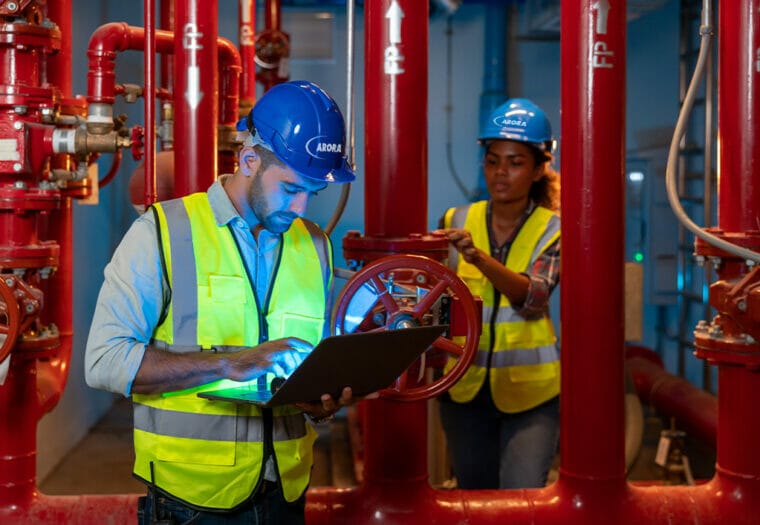News | Oct 09, 2023 | Anne Keener
Marking 101 Years of Fire Prevention: Ensuring Safety and Dispelling Myths
This year, we celebrate the 101st anniversary of Fire Prevention Week, a significant event sponsored by the National Fire Protection Association (NFPA). Fire Prevention Week is observed annually during the week of October 9th to commemorate the Great Chicago Fire and raise public awareness about fire safety. In the event of a fire, a matter of mere seconds can be the distinction between a safe escape and a tragic outcome.
Fire safety education isn’t limited to schoolchildren; teenagers, adults, and the elderly are all susceptible to the dangers of fires. Consequently, it is crucial for every member of the community to dedicate time during Fire Prevention Week each October to ensure they understand how to remain safe in the event of a fire.
Arora Engineers (Arora) boasts a dedicated Fire/Life Safety (FLS) practice that specializes in Fire Alarm and Fire Protection system design, as well as Fire Protection/Life Safety Consulting services. This expertise extends to a wide range of projects, from expansive, multi-million square foot facilities to intricate small-scale renovations.
Our team of fire and life safety engineers is committed to designing fire detection and suppression systems that safeguard both lives and property. With registered fire protection engineers (FPEs) and NICET Certified Designers, we offer our services across a broad geographic range, equipped with the experience to assess hazards and provide tailored solutions for all our clients.
To mark Fire Prevention Week, we sat down with some of our FLS team members to understand the significance of Fire Prevention and to dispel common myths associated with Fire/Life Safety:
Why is Fire Prevention important to you?
 Daniel O’Brien EIT, Fire/Life Safety Designer: “Fire protection systems are important to me because without them, there would be a lot more casualties and property damage without them. They are the first line of defense in the outbreak of a fire. Additionally, the building fire alarm system is able to start the evacuation process of a building well before the fire event spirals out of control and plays a key factor in the safety and survival of the population in a building.”
Daniel O’Brien EIT, Fire/Life Safety Designer: “Fire protection systems are important to me because without them, there would be a lot more casualties and property damage without them. They are the first line of defense in the outbreak of a fire. Additionally, the building fire alarm system is able to start the evacuation process of a building well before the fire event spirals out of control and plays a key factor in the safety and survival of the population in a building.”
 James Pazuchanics, Sr. Fire/Life Safety Designer: “As a teenager, I was woken by a smoke alarm in my bedroom due to a fan malfunctioning at the base of my bed. I guess you can say that I owe my life to the people in this profession. How many other professions can say that their work saves people’s lives?”
James Pazuchanics, Sr. Fire/Life Safety Designer: “As a teenager, I was woken by a smoke alarm in my bedroom due to a fan malfunctioning at the base of my bed. I guess you can say that I owe my life to the people in this profession. How many other professions can say that their work saves people’s lives?”

Arthur Simpson, SET, Lead Fire/Life Safety Designer: “Fire protection holds paramount importance as it plays a critical role in mitigating the risk of harm to both employees and customers, minimizing potential damage to structures and facilities, safeguarding against potential regulatory fines, and preserving job security for employees, which could be compromised in the event of significant structural damage. Fire protection systems constitute a vital component of safety in any operational facility, offering a substantial level of security for valuable equipment, property, essential documents, human lives, and inventory during fire incidents.”
What is a myth about Fire Prevention that not everyone knows about?
 Alex Benne, PE, Fire/Life Safety Discipline Lead: “One myth/misconception about fire sprinklers that I have heard many times is that the water damage from sprinkler discharge will be greater than the property damage from a fire in a building with no sprinklers. Fire sprinklers are designed to activate at the early stages of a fire and to control the fire to its area of origin. Without sprinklers, the fire will grow much larger before the fire department arrives, increasing the fire and smoke damage. A single fire sprinkler in a light hazard occupancy flows 15-25 gallons per minute while the flow from a fire hose can be in the range of 100-200 gpm. A fire hose uses about 8 times the amount of water than a sprinkler!”
Alex Benne, PE, Fire/Life Safety Discipline Lead: “One myth/misconception about fire sprinklers that I have heard many times is that the water damage from sprinkler discharge will be greater than the property damage from a fire in a building with no sprinklers. Fire sprinklers are designed to activate at the early stages of a fire and to control the fire to its area of origin. Without sprinklers, the fire will grow much larger before the fire department arrives, increasing the fire and smoke damage. A single fire sprinkler in a light hazard occupancy flows 15-25 gallons per minute while the flow from a fire hose can be in the range of 100-200 gpm. A fire hose uses about 8 times the amount of water than a sprinkler!”
 Daniel O’Brien EIT, Fire/Life Safety Designer: “The way fire alarm systems are portrayed in most movies/scenarios is that when the fire alarm system is activated via a pull station or a detector, that the sprinkler system automatically goes activates throughout the building. This is not true and pulling a pull station just sets off the strobes and horns in most cases.”
Daniel O’Brien EIT, Fire/Life Safety Designer: “The way fire alarm systems are portrayed in most movies/scenarios is that when the fire alarm system is activated via a pull station or a detector, that the sprinkler system automatically goes activates throughout the building. This is not true and pulling a pull station just sets off the strobes and horns in most cases.”
 James Pazuchanics, Sr. Fire/Life Safety Designer: “One myth is that ‘Fire protection systems come with the building and do not need to be reviewed or maintained unless there is a problem.’ While a building does require a working fire protection system to be occupied, the building code requires the system to be reviewed if the structure or occupancy type of the building changes. The code also requires the system to be maintained in working condition, inspected on an approved testing schedule, and monitored offsite if a 24/7 site monitoring center is not provided.”
James Pazuchanics, Sr. Fire/Life Safety Designer: “One myth is that ‘Fire protection systems come with the building and do not need to be reviewed or maintained unless there is a problem.’ While a building does require a working fire protection system to be occupied, the building code requires the system to be reviewed if the structure or occupancy type of the building changes. The code also requires the system to be maintained in working condition, inspected on an approved testing schedule, and monitored offsite if a 24/7 site monitoring center is not provided.”

Arthur Simpson, SET, Lead Fire/Life Safety Designer: “There are five common fire sprinkler myths perpetuated by Hollywood, including the notion that all sprinklers activate simultaneously, the idea that lighters or open flames can activate fire sprinklers (often from a considerable distance and within just a few seconds), the misconception that fire sprinklers can be activated via the internet or some sort of magical button, and the false notion that smoke alone can trigger the activation of fire sprinklers.”



